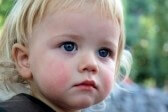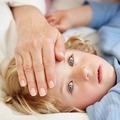Oligophrenia: symptoms, degrees, treatment
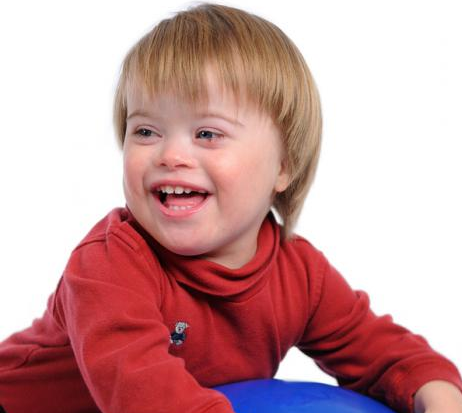
Oligophrenia is a group of diseases that differ in origin and severity.The manifestation of the disease is acquired in childhood or congenital dementia, as well as difficulties in adapting to the society.
People suffering from this disease can read and write, perform a simple mathematical account, do a simple job and even create families.The level of adaptation to the society depends largely on the nature of the disease and human behavior.At good-natured and quiet people life is quite successful.Aggressive and easily excitable patients often experience difficulties in interacting with people and in performing ordinary cases.Also they have a tendency to use toxic substances and vagrancy, getting under someone else's influence.
Contents: classification of mental retardation causes and factors of mental retardation Signs and symptoms of mental retardation Diagnostics Treatment of mental retardation Prevention mental retardation Complications and consequences of Diet for mental retardationclassification of mental retardation
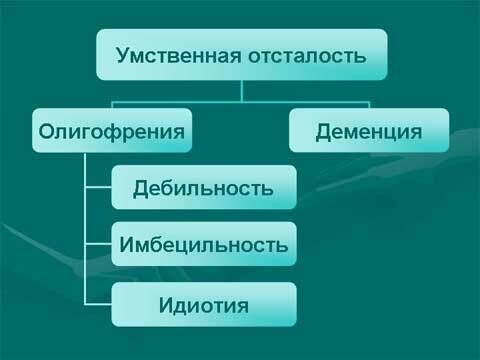
There are three degrees of mental retardation:
- Idiocy - theSevere form of the disease.A person does not talk, is not able to learn even the simplest skills to take care of himself.In such patients there is emotional confinement, lack of productive activity.They need special conditions of detention, constant care.
- Imbecility.People with a moderate degree of disease are distinguished by lack of initiative, primitive thinking, and easy suggestibility.They understand simple speech, pronounce short phrases, they can be taught to count, sometimes read and even write.Patients need constant care and supervision.Out of emotional reactions, they manifest shame, rancor, attachment.Those suffering imbecile react to the way they are praised or scolded.For such patients, there are special schools and medical facilities.
- Degeneracy is an easy degree of oligophrenia.It is difficult to diagnose in children, so they do it only when they reach the age of ten.There is a disease in the form of a lack of ability to perceive and express complex concepts, to think abstractly.Children experience isolation, fear in the new environment, a change in behavior, distracted attention, inadequate behavior.
Patients with mild degrees of oligophrenia often without problems master the speech sufficiently, can take care of themselves.The slow development of children in this case does not cause concern to others.The disease manifests itself at the beginning of learning activity and is expressed in the inability to memorize the material presented.Such patients are well-oriented in everyday life and can live independently.
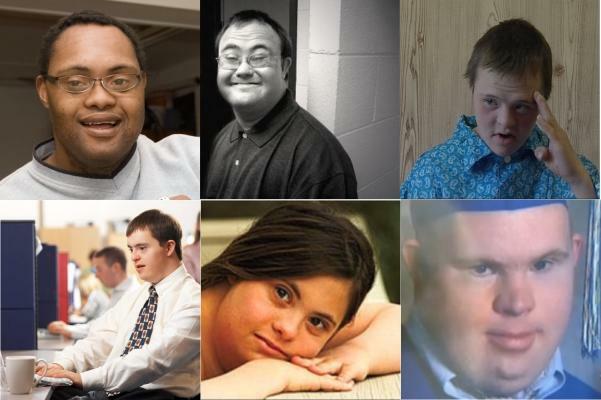
Causes and factors of occurrence of oligophrenia
The main causes of the disease:
- metabolic disorders at the genetic level;
- chromosomal abnormality;
- adverse effects on the ovum and sperm;
- detrimental effects on the baby in the womb.
In fact, this disease - dementia, completely captured the personality, showing insufficient intelligence.Noticeably this pathological condition is still in childhood, and it does not develop further.Symptoms can be expressed in disorders of the motor, speech and emotional systems.
Other causes of oligophrenia:
- intrauterine infections: toxoplasmosis, rubella in pregnant women;
- hormonal disorders, immune mother and fetus blood;
- alcoholism, drug addiction in the period of bearing a child;
- birth and postnatal trauma to the skull;
- genetic diseases;
- frequent application of X-ray;
- gross malnutrition and malnutrition, lack of iodine in a future mother;
- inadequate education and communication with the child in troubled families.
Signs and symptoms of oligophrenia
Dementia can be identified by drawing attention to the following symptoms:
- difficulty in adapting to a new environment;
- Distracted attention;
- restlessness;
- difficulties in compliance with the regime;
- bad behavior;
- lack of interest in learning;
- frequent migraines;
- partial paralysis of the limbs;
- lack of ability to generalize and remember;
- is an underdeveloped emotional side.
There is no personal formation in such people.Deviations are also observed at the physical level.Patients noticeable irregular skull structure, disproportion in the physique, lag in sexual development and growth.
There are often various defects, for example, a cleft lip, a small head with a large face and so on.Congenital disease is sometimes accompanied by a severe form, characterized by indifference, sluggish condition, periodic attacks of irritability.
Diagnostics
The diagnosis of oligophrenia is aimed at determining the severity of the disease and the causes of its appearance.Do this at an early age.To make an accurate diagnosis, specialists study the full history of the whole family, the data on the course of pregnancy of the mother of the child, the diseases transferred in this period, the peculiarities of childbirth and the first years of the baby's life.
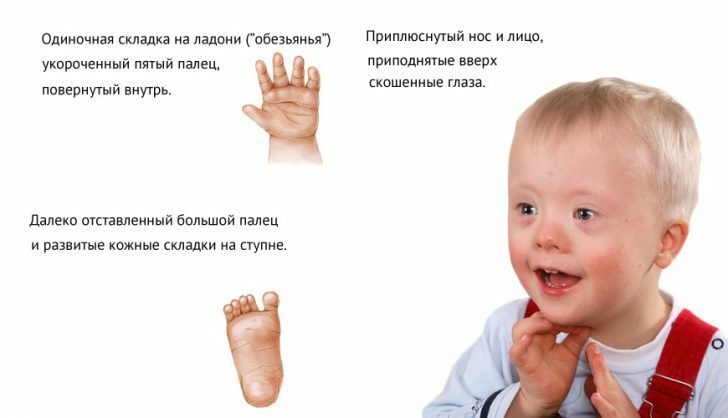
Clinical examination, studies of neurological, physical and intellectual abnormalities play no less role in the diagnosis.In addition, laboratory, psychological, pathophysiological studies are carried out.It turns out how often the child was ill with colds, how he ate.An assessment is made of the level of adaptation in society, relations with parents and surrounding people.
Magnetic resonance imaging and computed tomography of the head can help determine the existing damage to the brain tissue.
Treatment of oligophrenia
There are three types of treatment for this disease: symptomatic, corrective and specific.
Symptomatic treatment of oligophrenia depends on the origin of the disease and can be limited to anticonvulsant, general restorative therapy.In addition, drugs are used to stimulate mental processes.
Corrective treatment - special training methods, psychological support, assistance to patients in social adaptation and so on.Carried out in the relevant institutions.It is used for mild to moderate disease.
Specific treatment of oligophrenia is prescribed by a specialist depending on the severity of the disease.Provides for the use of a special diet, substitution therapy.
Severe forms of the disease are accompanied by the need for constant care and supervision in special clinics and homes for people with disabilities.
Treatment is appointed by a specialist after a thorough diagnosis.Usually, tranquilizers, nootropics, neuroleptics, hormones or medications containing iodine are used.
Traditional medicine suggests replacing nootropic preparations with decoctions of ginseng, magnolia vine, and also aloe juice.All these medicinal plants positively influence the activity of the brain, activating it.However, without consulting a specialist, it is not recommended to take them.Ignorance of the scheme of their proper use and dose can lead to the appearance of psychoses, anger and aggression in the patient.
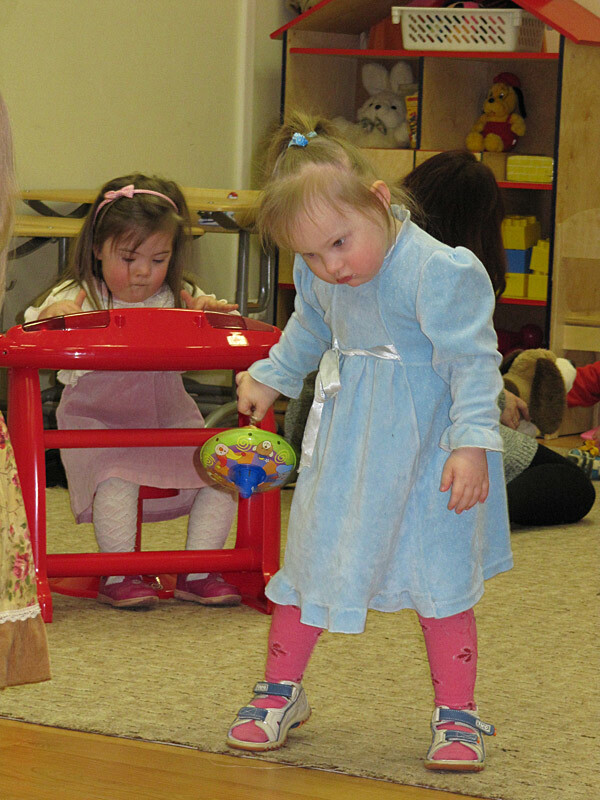 To treat a child in the presence of symptoms of oligophrenia, one can start from an early age - from the moment the diagnosis is made.Only a doctor chooses a therapy scheme, this is done taking into account the characteristics of a particular child.In addition, the specialist appoints a special diet.
To treat a child in the presence of symptoms of oligophrenia, one can start from an early age - from the moment the diagnosis is made.Only a doctor chooses a therapy scheme, this is done taking into account the characteristics of a particular child.In addition, the specialist appoints a special diet.
Used drugs are designed to improve metabolic processes in the brain tissues.In addition to medicines, vitamins and amino acids are prescribed.
In case of behavioral disorders, neuroleptics or tranquilizers must be prescribed.The effectiveness of treatment depends on the measures aimed at rehabilitation of the patient with oligophrenia.That is, it is necessary to provide professional help in correcting his behavior.Correction of behavior and socialization of patients is carried out by specialized schools, where children are taught school knowledge and help to master a simple profession.
The average and severe form of the disease in children requires constant care and monitoring of the state of health.At the first signs of oligophrenia, the baby should urgently seek advice from specialists.Complete diagnosis will help determine the extent of the disease and prescribe effective therapy.
In order not to miss the moment, parents need to constantly monitor the health and behavior of their child.The sooner a disease is discovered, the more chances for effective socialization of the child.
Prevention of oligophrenia
Preventative measures include family counseling, where the disease is hereditary.Recommended special methods of serving babies, their adaptation to the society.
Measures to prevent oligophrenia in a unborn child during a mother's pregnancy include:
-
 regular visit to a female consultation, obstetrician-gynecologist;
regular visit to a female consultation, obstetrician-gynecologist; - timely registration;
- refusal of smoking and alcohol;
- walks for two hours every day;
- the correct mode of the day;
- eight-hour high-grade dream;
- balanced nutrition;
- rejection of harmful food: fried, canned, hot, hot;
- correct obstetric care, prevention of the use of forceps.
Complications and consequences
Complications of oligophrenia include violations of labor and social adaptation with a pronounced lack of intelligence.With severe and moderate severity of the disease, antisocial aggressive behavior, assassination attempts, suicidal tendencies, and the like can develop.
Diet for oligophrenia
The development of dementia can be stopped at an early age by starting timely treatment.In the course of therapy, experts recommend that protein foods, legumes and flour products be excluded from the baby's diet, replacing them with Berlofan.
To stimulate the activity of the brain of patients with oligophrenia, it is necessary to include in the diet products containing B vitamins, as well as dishes made from vegetables and fruits.
As a preventive measure of the disease, pregnant women are shown adequate nutrition, which reduces the risk of infections, increases immunity.
Trofimova Yaroslava, medical reviewer


